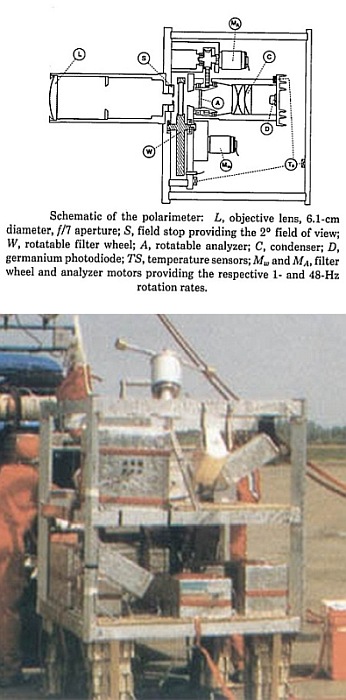Purpose of the flight and payload description
RADIBAL (RADIomètre BALlon) was a photo-polarimeter developed in 1982 by the Laboratoire d'Optique Atmosphérique (LOA), Université des Sciences et Technologies de Lille in France. Its goal was to measure at two near-infrared wavelengths, the radiance and the degree of polarization of sunlight scattered from the stratospheric aerosol at various angles.
A schematic of the polarimeter optical system can be seen at left and a view of the gondola on which it was mounted(click to enlarge) . The entrance radiance was spectrally filtered by a filter wheel (W), then passed through a rotating analyzer (A), and finally was focused on detector (D). The objective lens had a diameter of 6.1 cm; the field stop (S) in its focal plane provided a 2º field of view; the lens aperture was f/7. The condensed beam passed through the filters just behind (S) being its diameter 6 mm. There were two filters: one for the 850nm wavelength and the other for the 1650 nm wavelength with a diameter of 50 mm. Both filters were mounted on the rotating wheel (W). Given the respective diameters of the wheel, the filters, and the beam, each filter was full-beam positioned within a 48º rotation of (W). Since the detector sensitivity was quite constant regardless of the polarization state of the received light, the polarization analysis was provided by a simple rotating analyzer (Infrared H.C. Polaroid).
The double condenser (C) finally imaged the field stop into detector (D) a Judson germanium photodiode of 3-mm diameter. Given radiance computations for stratosphere standards on the one hand and the previous choices for the field of view, the entrance lens, and the spectral bandwidths on the other hand, the derived power budget showed that the degree of linear polarization could be measured within ±0.01 at 25-km altitude.
The germanium photodiode was operated in the photovoltaic mode at a temperature of -27.40 C, with the thermal regulation being provided by a cooling Peltier device. An inverting amplifier used for the first amplification stage bringed the signal up to a usable level. A second amplification stage imposed three different gain levels: X1, X10, and X100. Then the signal was taken by an analog-to-digital conversor resulting in a 12-bit digitized stream which was treated by an onboard Intel 8085 microprocessor; thus, after a full revolution of the filter wheel the onboard telemetry system transmited the data stream along with several housekeeping parameters and positioning information to the ground station.
The entire instrument was packaged in three distinct units: the polarimeter with its detector amplification system, the data processing electronics, and the battery supply. These unpressurized units were thermally insulated by polystyrene housings. Moreover, a heater was incorporated in the polarimeter unit, so when temperature reached -7°C, the cooling Peltier device of the detector was activated.
The polarimeter was fixed on a stratospheric platform carefully leveled before the launch whose angular scan was provided by a nominal spin rate of 1 rpm. The horizontality of the observation direction was checked from an onboard inclinometer while the azimuth was obtained from an onboard magnetometer. Finally, the solar elevation and azimuth were obtained from the balloon geographical position along with the time of the measurement.
As a complementary payload was also onboard the gondola for this mission another instrument developed also at LOA: BALLAD (BALloon Limb Aerosol Detection) aimed at studying the scattering properties of the stratospheric aerosol by measuring the intensity (at 450, 600 and 850 nm) and the polarization (at 850 nm) of the Earth's limb, for a wide range of scattering angles. An inversion method of the radiances only, obtained in forward scattering, has been developped to retrieve the vertical profiles of the extinction coefficient and of an asymetry parameter of the aerosol. The objective of the instrument formed the Earth's limb image on a linear charge-coupled device (CCD) detector of 1728 pixels, the vertical FOV of the system was about 6°. A filter wheel, located between the objective and the detector, allowed multispectral radiance and polarization measurements to be performed. Two interference filters at 850 and 450 nm were dedicated to aerosol studies and a third channel centered at 600 nm was deployed for ozone detection. Three other filters centered at 850 nm were equipped with polaroids rotated by 60° with respect to one other to evaluate the linear degree of polarization of scattered light.
BALLAD was installed on board of the gondola with its optical axis, pointing approximately 2° below the balloon horizon. Combined with its large vertical FOV allowed observation of all the stratospheric layers, from the tropopause up to the balloon level, simultaneously with one exposure. The vertical resolution was about 350 m for a balloon ceiling at 30 km and a tangent height equal to 15 km. Measurements were carried out for solar elevation ranging from 2 to 10° and the rotation of the gondola around the vertical axis (1/3 rpm) permited BALLAD to observe Earth's limb for various azimuth angles (angular sampling 16°).
Details of the balloon flight
Balloon launched on: 1/25/1994 at 8:41 utc
Launch site: European Space Range, Kiruna, Sweden
Balloon launched by: Centre National d'Etudes Spatiales (CNES)
Balloon manufacturer/size/composition: Zero Pressure Balloon model 100sf Zodiac - 100.000 m3
Balloon serial number: 100 SF Nº 209
End of flight (L for landing time, W for last contact, otherwise termination time): 1/25/1994 at ~ 09:00
Balloon flight duration (F: time at float only, otherwise total flight time in d:days / h:hours or m:minutes - ): 22 m
Campaign: ESOPE
Payload weight: 507 kgs
Gondola weight: 265 kgs
Bad flight.
External references
- RADIBAL website Laboratoire d'Optique Atmosphérique, Université Lille
- List of balloons launched from ESRANGE SSC Space website (via Archive.Org)
1211If you consider this website interesting or useful, you can help me to keep it up and running with a small donation to cover the operational costs. Just the equivalent of the price of a cup of coffee helps a lot.


